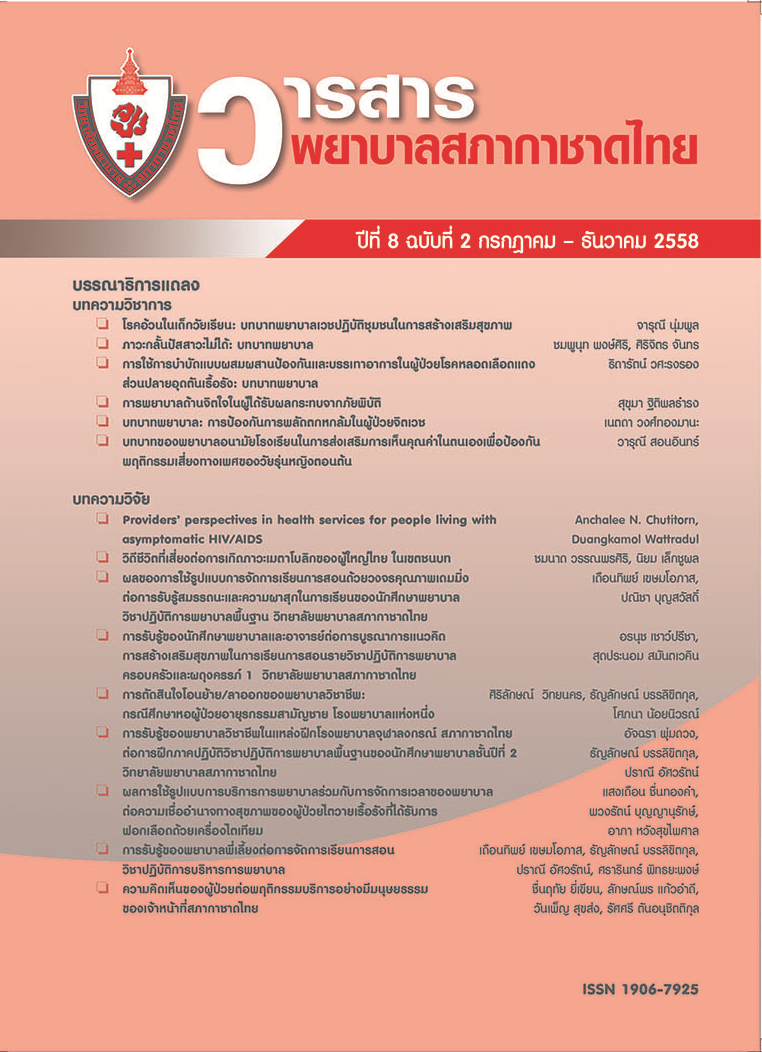ภาวะกลั้นปัสสาวะไม่ได้: บทบาทพยาบาล
Keywords:
ภาวะกลั้นปัสสาวะไม่ได้, บทบาทพยาบาล, urinary incontinence, nurse’s roleAbstract
ภาวะกลั้นปัสสาวะไม่ได้/ปัสสาวะเล็ด เป็นภาวะที่บุคคลไม่สามารถควบคุมหูรูดทางเปิดของท่อปัสสาวะได้ ทำให้มีปัสสาวะเล็ด กระปริดกระปรอยหรือปัสสาวะราด ภาวะกลั้นปัสสาวะไม่ได้/ปัสสาวะเล็ดเกิดขึ้นได้จากหลายสาเหตุ พบมากในสตรีวัยสูงอายุ ภาวะกลั้นปัสสาวะไม่ได้มี 2 แบบคือแบบถาวรและแบบชั่วคราว แบ่งออกเป็น 5 ชนิด ในขั้นตอนแรกของการวินิจฉัยภาวะกลั้นปัสสาวะไม่ได้ต้องแยกชนิดอย่างถูกต้อง เพื่อให้การรักษาได้อย่างมีประสิทธิภาพ แนวทางการรักษาจะปฏิบัติเป็นขั้นตอน เริ่มจากการรักษาที่ไม่ซับซ้อนและไม่ล่วงล้ำเข้าไปในร่างกายผู้รับบริการ ถ้าไม่ได้ผลจึงใช้อุปกรณ์ช่วย ใช้การรักษาด้วยยา และวิธีการรักษาแนวใหม่ตามลำดับ และถ้ายังไม่สามารถแก้ไขปัญหาได้จึงใช้การผ่าตัด พยาบาลมีบทบาทความสำคัญในการดูแลผู้มีภาวะกลั้นปัสสาวะไม่ได้ ด้วยการสอนวิธีปฏิบัติให้ถูกต้องในเรื่องพฤติกรรมบำบัด การใช้อุปกรณ์ป้องกันการไหลของน้ำปัสสาวะ การดูแลผิวหนังให้สะอาด และการดูแลด้านจิตใจ เพื่อให้ผู้รับบริการมีคุณภาพชีวิตที่ดี บทความนี้จะนำเสนอประเภท และสาเหตุ การวินิจฉัยการกลั้นปัสสาวะไม่ได้ การรักษา และบทบาทพยาบาล
Urinary incontinence: nurses’ role
Urinary incontinence is a condition in which a person cannot control the urethral sphincter. They can lose a few drops or a large amount of urine. Urinary incontinence has many causes and is more common in older women. It can be both permanent and transient. Urinary incontinence is divided into five types, and diagnosis of urinary incontinence can be sorted correctly in order to treat effectively. Treatment guidelines of urinary incontinence is a stepped-care plan starting with noninvasive treatment followed by pharmacologic devices, radiofrequency energy and finally surgery in those whose symptoms do not respond to initial treatment. Nurses play a role in providing care for patients with urinary incontinence though teaching the patients how to change their behavior, applying urinary devices, treating skin care, and also offering psychological care to provide quality of life. This article presents the types, causes, diagnosis, and treatment of urinary incontinence and the nurse’s role.
Downloads
Issue
Section
License
เนื้อหาบทความหรือข้อคิดเห็นต่างๆ ในวารสารพยาบาลสภากาชาดไทยนี้ เป็นความคิดเห็นของผู้เขียนบทความ ไม่ใช่ความเห็นของกองบรรณาธิการ หรือสถาบันการพยาบาลศรีสวรินทิรา สภากาชาดไทย






